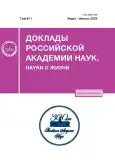THE ROLE OF NEUROHUMORAL IMBALANCE AT POST-TRAUMATIC STRESS DISORDER IN THE ANTITUMOR IMMUNE RESPONSE. EXPERIMENTAL STUDY
- Authors: Kondashevskaya M.V.1, Artemieva K.A.1, Aleksankina V.V.1, Kudelkina V.V.1, Kosyreva A.M.1, Areshidze D.A.1, Kozlova M.A.1, Mikhaleva L.M.1
-
Affiliations:
- Avtsyn Research Institute of human morphology of Federal State Budgetary Scientific Institution “Petrovsky National Research Centre of surgery”
- Issue: Vol 511, No 1 (2023)
- Pages: 333-339
- Section: Articles
- URL: https://journals.rcsi.science/2686-7389/article/view/135641
- DOI: https://doi.org/10.31857/S2686738923600127
- EDN: https://elibrary.ru/IYYKGS
- ID: 135641
Cite item
Full Text
Abstract
The aim of the study was to investigate the growth and development of B16 melanoma in mature male C57Black/6 mice with a post-traumatic stress disorder (PTSD) model. Behavioral, immunohistochemical, morphometric methods, enzyme immunoassay were used. A forced decrease in the level of corticosterone, which is characteristic for PTSD, was established, followed by an intensification of the production of increased concentrations of pro-inflammatory interleukins by the cells of the immune system and, at the same time, a decrease in the secretion of anti-inflammatory cytokines. Priority data were obtained: the neurohumoral imbalance that develops in PTSD is a limiting factor to the growth of B16 melanoma, at least at the initial stages of the oncological process.
About the authors
M. V. Kondashevskaya
Avtsyn Research Institute of human morphology of Federal State Budgetary Scientific Institution “Petrovsky National Research Centre of surgery”
Author for correspondence.
Email: marivladiko@mail.ru
Russian Federation, Moscow
K. A. Artemieva
Avtsyn Research Institute of human morphology of Federal State Budgetary Scientific Institution “Petrovsky National Research Centre of surgery”
Email: marivladiko@mail.ru
Russian Federation, Moscow
V. V. Aleksankina
Avtsyn Research Institute of human morphology of Federal State Budgetary Scientific Institution “Petrovsky National Research Centre of surgery”
Email: marivladiko@mail.ru
Russian Federation, Moscow
V. V. Kudelkina
Avtsyn Research Institute of human morphology of Federal State Budgetary Scientific Institution “Petrovsky National Research Centre of surgery”
Email: marivladiko@mail.ru
Russian Federation, Moscow
A. M. Kosyreva
Avtsyn Research Institute of human morphology of Federal State Budgetary Scientific Institution “Petrovsky National Research Centre of surgery”
Email: marivladiko@mail.ru
Russian Federation, Moscow
D. A. Areshidze
Avtsyn Research Institute of human morphology of Federal State Budgetary Scientific Institution “Petrovsky National Research Centre of surgery”
Email: marivladiko@mail.ru
Russian Federation, Moscow
M. A. Kozlova
Avtsyn Research Institute of human morphology of Federal State Budgetary Scientific Institution “Petrovsky National Research Centre of surgery”
Email: marivladiko@mail.ru
Russian Federation, Moscow
L. M. Mikhaleva
Avtsyn Research Institute of human morphology of Federal State Budgetary Scientific Institution “Petrovsky National Research Centre of surgery”
Email: marivladiko@mail.ru
Russian Federation, Moscow
References
- Ferlay J., Ervik M., Lam F., et al. Global Cancer Observatory: Cancer Today // Lyon: International Agency for Research on Cancer; 2020 https://gco.iarc.fr/today. Ссылка активна на 15 февраля 2023 г.
- Cabaço L.C., Tomás A., Pojo M., et al. The Dark Side of Melanin Secretion in Cutaneous Melanoma Aggressiveness // Front Oncol. 2022. V. 12. P. 887366.
- Rebecca V.W., Somasundaram R., Herlyn M. Pre-clinical modeling of cutaneous melanoma // Nat Commun. 2020. V. 11. № 1. P. 2858.
- Schmidberger H., Rapp M., Ebersberger A et al. Long-term survival of patients after ipilimumab and hypofractionated brain radiotherapy for brain metastases of malignant melanoma: sequence matters // Strahlenther Onkol. 2018. V. 194. № 12. P. 1144–1151. https://doi.org/10.1007/s00066-018-1356-5
- Russell G., Lightman S. The human stress response // Nat Rev Endocrinol. 2019. V. 15. № 9. P. 525–534.
- Shin K.J., Lee Y.J., Yang Y.R., et al. Molecular Mechanisms Underlying Psychological Stress and Cancer // Curr Pharm Des. 2016. V. 22. № 16. P. 2389–402.
- Rudak P.T., Choi J., Parkins K.M., et al. Chronic stress physically spares but functionally impairs innate-like invariant T cells // Cell Rep. 2021. Vol. 35. № 2. P. 108979.
- Yehuda R., Seckl J. Minireview: Stress-related psychiatric disorders with low cortisol levels: a metabolic hypothesis // Endocrinology. 2011. V. 15212. P. 4496–503.
- Brown L.C., Murphy A.R., Lalonde C.S., et al. Posttraumatic stress disorder and breast cancer: Risk factors and the role of inflammation and endocrine function // Cancer. 2020. V. 126. № 14. P. 3181–3191.
- Кондашевская М.В., Цейликман В.Э., Комелькова М.В., и др. Соотношение физической усталости и морфофункционального состояния миокарда при экспериментальном хроническом стрессе // Доклады РАН. 2019. Т. 485. № 2. С. 247–250.
- Кондашевская М.В., Комелькова М.В., Цейликман В.Э., и др. Новые нейробиологические критерии профиля устойчивости при моделировании посттравматического стрессового расстройства // Доклады РАН. Науки о жизни, 2021. Т. 501. № 1. С. 522–527.
- Nahum K., Todder D., Zohar J., et al. The Role of Microglia in the (Mal) adaptive Response to Traumatic Experience in an Animal Model of PTSD // Int J Mol Sci. 2022. V. 23. № 13. P. 7185.
- Cohen H., Matar M.A., Joseph Z. Animal models of post-traumatic stress disorder // Curr Protoc Neurosci. 2013. Ch. 9. Unit 9.45.
- Янин В.Л., Бондаренко О.М., Сазонова Н.А. Методы исследования в цитологии и гистологии: учебно-методическое пособие для аспирантов заочной формы обучения к практическим занятиям по дисциплине. Ханты-Мансийск: БУ “Ханты-Мансийская государственная медицинская академия”, 2015.
- Kerr J.F.R., Gobe G.C., Winterford C.M., et al. // Meth. Cell Biol. 1995. V. 46. P. 1–27.
- Banfalvi G. Methods to detect apoptotic cell death // Apoptosis. 2017. V. 22. № 2. P. 306–323.
- Eswarappa M., Neylan T.C., Whooley M.A., et al. Inflammation as a predictor of disease course in posttraumatic stress disorder and depression: A prospective analysis from the Mind Your Heart Study // Brain Behav Immun. 2019. V. 75: 220–227.
- Dickson P.V., Gershenwald J.E., Staging and Prognosis of Cutaneous Melanoma // Surg Oncol Clin N Am. 2011. V. 20. № 1. P. 1–17.
- Aliev G., Beeraka N.M., Nikolenko V.N., et al. Neurophysiology and Psychopathology Underlying PTSD and Recent Insights into the PTSD Therapies-A Comprehensive Review // J Clin Med. 2020. V. 9. № 9. P. 2951.
- Lee H.K., Shin H.J., Koo J., et al. Blockade of transforming growth factor β2 by anti-sense oligonucleotide improves immunotherapeutic potential of IL-2 against melanoma in a humanized mouse model // Cytotherapy. 2021. V. 23. № 7. P. 599–607.
Supplementary files













